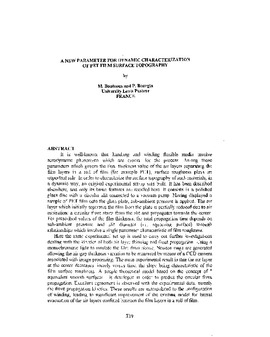| dc.contributor.author | Boutaous, M. | |
| dc.contributor.author | Bourgin, P. | |
| dc.contributor.other | International Conference on Web Handling (1999) | |
| dc.date.accessioned | 2019-11-07T15:30:26Z | |
| dc.date.available | 2019-11-07T15:30:26Z | |
| dc.date.issued | 1999-06 | |
| dc.identifier | oksd_icwh_1999_boutaous | |
| dc.identifier.citation | Boutaous, M., & Bourgin, P. (1999, June). A new parameter for dynamic characterization of PET film surface topography. Paper presented at the Fifth International Conference on Web Handling (IWEB), Stillwater, OK. | |
| dc.identifier.uri | https://hdl.handle.net/11244/321801 | |
| dc.description.abstract | It is well-known that handling and winding flexible media involve aerodynamic phenomena which are crucial for the process. Among those parameters which govern the final thickness value of the air layers separating the film layers in a roll of film (for example PET), surface roughness plays an important role. In order to characterize the surface topography of such materials, in a dynamic way, an original experimental set-up was built. It has been described elsewhere, and only its basic features are recalled here. It consists in a polished glass disc with a circular slit connected to a vacuum pump. Having displayed a sample of PET film onto the glass plate, sub-ambient pressure is applied. The air layer which initially separates the film from the plate is partially reduced due to air aspiration: a circular front starts from the slit and propagates towards the center. For prescribed values of the film thickness, the total propagation time depends on sub-ambient pressure and slit diameter (i.e. squeezing surface) through relationships which involve a single parameter characteristic of film roughness. | |
| dc.description.abstract | Here the same experimental set up is used to carry out further investigations dealing with the kinetics of both air layer thinning and front propagation. Using a monochromatic light to insulate the film from above, Newton rings are generated allowing the air gap thickness variation to be measured by means of a CCD camera associated with image processing. The main experimental result is that the air layer at the center decreases linearly versus time, the slope being characteristic of the film surface roughness. A simple theoretical model based on the concept of " equivalent smooth surfaces " is developed in order to predict the circular front propagation. Excellent agreement is observed with the experimental data, namely the front propagation kinetics. These results are extrapolated to the configuration of winding, leading to significant improvement of the existing model for lateral evacuation of the air layers confined between the film layers in a roll of film. | |
| dc.format | application/pdf | |
| dc.language | en_US | |
| dc.publisher | Oklahoma State University | |
| dc.rights | In the Oklahoma State University Library's institutional repository this paper is made available through the open access principles and the terms of agreement/consent between the author(s) and the publisher. The permission policy on the use, reproduction or distribution of the article falls under fair use for educational, scholarship, and research purposes. Contact Digital Resources and Discovery Services at lib-dls@okstate.edu or 405-744-9161 for further information. | |
| dc.title | New parameter for dynamic characterization of PET film surface topography | |
| osu.filename | oksd_icwh_1999_boutaous.pdf | |
| dc.type.genre | Conference proceedings | |
| dc.type.material | Text | |
